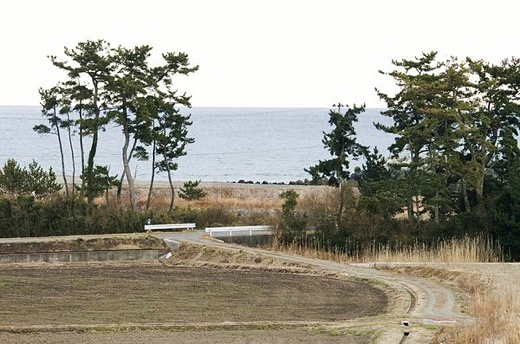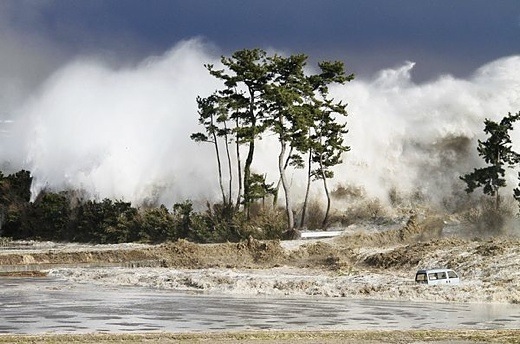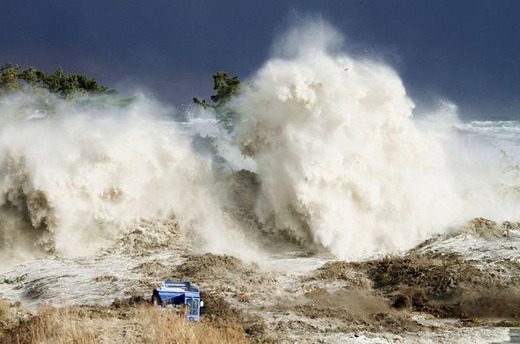SUBHEAD: The devastation to Japan will persist in long term economic impoverishment and environmental degradation.
By Juan Wilson on 11 March 2012 for Island Breath -
(http://islandbreath.blogspot.com/2012/03/1st-tohoku-earthquake-anniversary.html)
Image above: Moments before tsunami wave made shore in Sendai Provence on 3/11/11. From (http://news.nationalgeographic.com/news/2011/03/pictures/110324-japan-tsunami-pictures-new-fukushima-science-world/#/japan-tsunami-earthquake-new-pictures-before_33636_600x450.jpg).
It's one year out and Japan is still reeling from the 9.0 magnituse Tohuku Earthquake. Besides the violent ground movement, the tsunami that followed destroyed much of the remaining infrastructure in northeast Japan.
Even though the Japanese have committed almost a quarter of a trillion dollars to rebuild residences and transportation, things will never be the same. The tsunami struck first the Sendai are of Japan where agriculture and fishing industry was concentrated. With its aging population and decades old economic stagnation, it is unlikely that those industries will ever be the same.
Nuclear Meltdown
The tsunami destruction radiated outward along the northwest shores and soon enveloped the Fukushima Daiichi Nuclear Power Plant and in addition to the earthquake damage caused the meltdown of three of its six reactors.
The reactor meltdowns spewed tons of radioactive isotopes onto thousands of square miles of surrounding rural land as well as high into the atmosphere reaching Hawaii and the US mainland.
Moreover, the utility company had a devastating China Syndrome. That's where a large quantity of heavy radioactive elements burn through the foundation of the containment building and reach the underlying water table causing a hydro-volcanic explosion that would deliver tons of hot uranium and plutonium particles into the atmosphere.
To avoid the China Syndrome Tepco (the utility) poured thousands of tons of seawater into the ruined nuclear containment buildings as coolant, and then had to flush that radioactive water into the Pacific Ocean.

Image above: Moment of impact of tsunami on shore if Sendai Provence on 3/11/11. From (http://news.nationalgeographic.com/news/2011/03/pictures/110324-japan-tsunami-pictures-new-fukushima-science-world/#/japan-tsunami-earthquake-new-pictures-wave_33638_600x450.jpg).
Long Term Health
The Fukushima district had to be evacuated. All told there are still tens of thousands of Japanese still living in temporary structures far from home. The land in Fukushima has been poisoned. Grain, vegetable and dairy production as well as fish catch has been decimated in northeast Japan.
Millions of Japanese have been forced to live in an environment of increased long-term low-level radiation. This will last for generations and particularly effect the young, particularly women. The older, male dominated institutions of Japan have responded by raising the acceptable "safe" levels of exposure to ionizing radiation from 2 millisieverts/year to 20 millisieverts/year (2rem).
It has been demonstrated from data in the National Academy of Science's BEIR (Biological Effects of Ionizing Radiation) VII Report that at least one out of every 20 young girls (5%) living in an area where the radiological exposure is 20 millisieverts for five years will develop cancer in their lifetime.
See "Japan Condemns Fukushima Children (http://islandbreath.blogspot.com/2012/03/japan-condemns-children-of-fukushima.html).

Image above: Tsunami making its way inland in Sendai Provence on 3/11/11. From (http://news.nationalgeographic.com/news/2011/03/pictures/110324-japan-tsunami-pictures-new-fukushima-science-world/#/japan-tsunami-earthquake-new-pictures-hitting_33637_600x450.jpg).
Long Term View
In the meantime the nuclear power industry has been set back for quite some time. A year after the disaster only 2 of Japan's nuclear plants are online.
Although throughout Asia is racing to complete as many as 60 new nuclear reactors, the Japanese may be more accurately pointing to the future. They may not have come fully accepting of the fate that awaits them, they have moved closer to a smaller, aging population with a steady-state economy.
Something with world desperately needs more of. In his book "Collapse" Jared Diamond explores why human cultures meet their own ends. He also gives examples of how a few isolated island civilizations came to be durable and self-sustaining over a long history. The only large community he found that achieved that end was Japan prior to European contact.
Yes it was royalist. Yes it was isolationist. Yes it was xenophobic. But the Japanese managed a highly evolved culture over centuries without destroying their island environment. With no coal or petroleum the Japanese won't be able to have a 21st Century industrial economy without nuclear power.
But they cannot afford nuclear power and the world cannot afford an 21st century industrial economy.
We have had our own trouble.
The unfixed aftermath of Katrina hitting New Orleans and the BP oil well disaster despoiling the Gulf of Mexico illustrate America's inability to deal with natural and man-made disaster. We are poorer because of it. Let us hope the Japanese can show us a way in the dark. .
By Juan Wilson on 11 March 2012 for Island Breath -
(http://islandbreath.blogspot.com/2012/03/1st-tohoku-earthquake-anniversary.html)

Image above: Moments before tsunami wave made shore in Sendai Provence on 3/11/11. From (http://news.nationalgeographic.com/news/2011/03/pictures/110324-japan-tsunami-pictures-new-fukushima-science-world/#/japan-tsunami-earthquake-new-pictures-before_33636_600x450.jpg).
It's one year out and Japan is still reeling from the 9.0 magnituse Tohuku Earthquake. Besides the violent ground movement, the tsunami that followed destroyed much of the remaining infrastructure in northeast Japan.
Even though the Japanese have committed almost a quarter of a trillion dollars to rebuild residences and transportation, things will never be the same. The tsunami struck first the Sendai are of Japan where agriculture and fishing industry was concentrated. With its aging population and decades old economic stagnation, it is unlikely that those industries will ever be the same.
Nuclear Meltdown
The tsunami destruction radiated outward along the northwest shores and soon enveloped the Fukushima Daiichi Nuclear Power Plant and in addition to the earthquake damage caused the meltdown of three of its six reactors.
The reactor meltdowns spewed tons of radioactive isotopes onto thousands of square miles of surrounding rural land as well as high into the atmosphere reaching Hawaii and the US mainland.
Moreover, the utility company had a devastating China Syndrome. That's where a large quantity of heavy radioactive elements burn through the foundation of the containment building and reach the underlying water table causing a hydro-volcanic explosion that would deliver tons of hot uranium and plutonium particles into the atmosphere.
To avoid the China Syndrome Tepco (the utility) poured thousands of tons of seawater into the ruined nuclear containment buildings as coolant, and then had to flush that radioactive water into the Pacific Ocean.

Image above: Moment of impact of tsunami on shore if Sendai Provence on 3/11/11. From (http://news.nationalgeographic.com/news/2011/03/pictures/110324-japan-tsunami-pictures-new-fukushima-science-world/#/japan-tsunami-earthquake-new-pictures-wave_33638_600x450.jpg).
Long Term Health
The Fukushima district had to be evacuated. All told there are still tens of thousands of Japanese still living in temporary structures far from home. The land in Fukushima has been poisoned. Grain, vegetable and dairy production as well as fish catch has been decimated in northeast Japan.
Millions of Japanese have been forced to live in an environment of increased long-term low-level radiation. This will last for generations and particularly effect the young, particularly women. The older, male dominated institutions of Japan have responded by raising the acceptable "safe" levels of exposure to ionizing radiation from 2 millisieverts/year to 20 millisieverts/year (2rem).
It has been demonstrated from data in the National Academy of Science's BEIR (Biological Effects of Ionizing Radiation) VII Report that at least one out of every 20 young girls (5%) living in an area where the radiological exposure is 20 millisieverts for five years will develop cancer in their lifetime.
See "Japan Condemns Fukushima Children (http://islandbreath.blogspot.com/2012/03/japan-condemns-children-of-fukushima.html).

Image above: Tsunami making its way inland in Sendai Provence on 3/11/11. From (http://news.nationalgeographic.com/news/2011/03/pictures/110324-japan-tsunami-pictures-new-fukushima-science-world/#/japan-tsunami-earthquake-new-pictures-hitting_33637_600x450.jpg).
Long Term View
In the meantime the nuclear power industry has been set back for quite some time. A year after the disaster only 2 of Japan's nuclear plants are online.
Although throughout Asia is racing to complete as many as 60 new nuclear reactors, the Japanese may be more accurately pointing to the future. They may not have come fully accepting of the fate that awaits them, they have moved closer to a smaller, aging population with a steady-state economy.
Something with world desperately needs more of. In his book "Collapse" Jared Diamond explores why human cultures meet their own ends. He also gives examples of how a few isolated island civilizations came to be durable and self-sustaining over a long history. The only large community he found that achieved that end was Japan prior to European contact.
Yes it was royalist. Yes it was isolationist. Yes it was xenophobic. But the Japanese managed a highly evolved culture over centuries without destroying their island environment. With no coal or petroleum the Japanese won't be able to have a 21st Century industrial economy without nuclear power.
But they cannot afford nuclear power and the world cannot afford an 21st century industrial economy.
We have had our own trouble.
The unfixed aftermath of Katrina hitting New Orleans and the BP oil well disaster despoiling the Gulf of Mexico illustrate America's inability to deal with natural and man-made disaster. We are poorer because of it. Let us hope the Japanese can show us a way in the dark. .
1 comment :
Thank you Juan Wilson,
Thanks for this post, its an eye opener and I really appreciate your reflection on how Japan initially built itself up from minimal resources in the first place.
I love Japan and I am faithful that they can survive and turn this situation around.
I have faith in them delivering the people and Japan to a secure level of survival.
Post a Comment